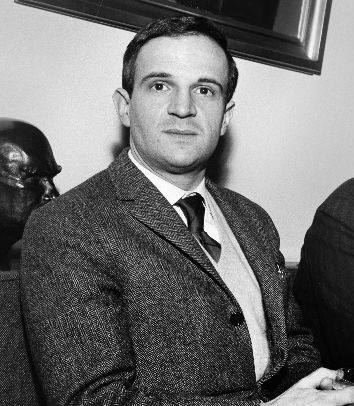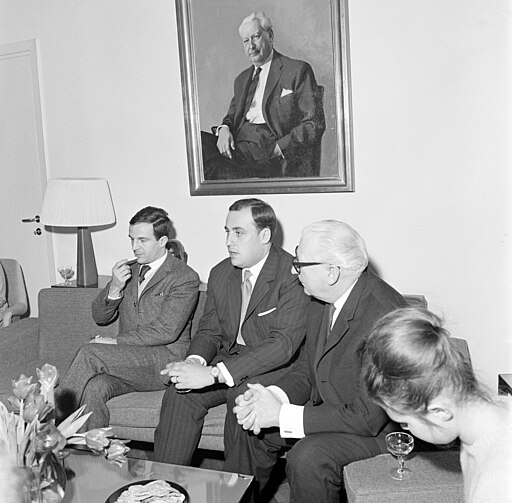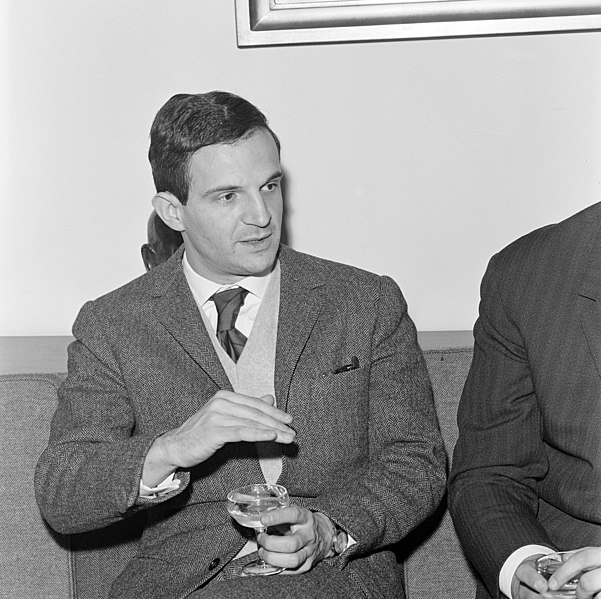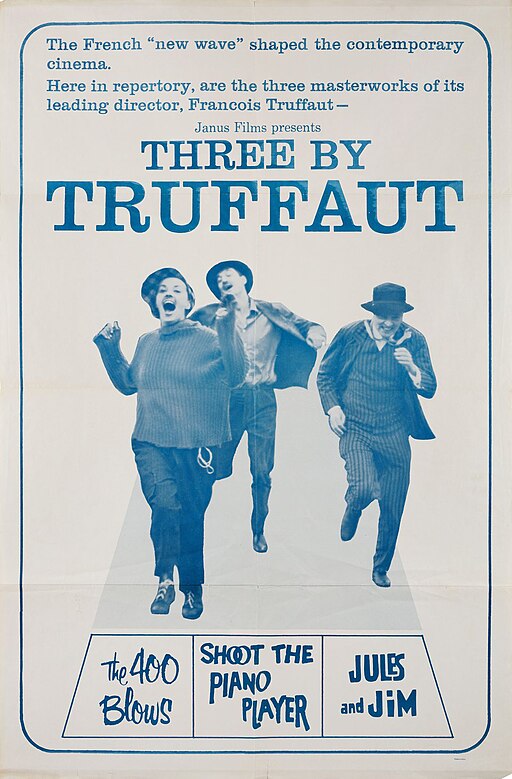François Truffaut
back| Full Name | François Roland Truffaut |
| Born | February 6, 1932 |
| Birthplace | Paris, France |
| Died | October 21, 1984 |
| Buried | Montmartre Cemetery, Paris, France |
| Married to | Madeleine Morgenstern (married 1957; divorced 1965) |
| Children | Laura Truffaut (born 1959) - Eva Truffaut (born 1961) |
| Notable films | The 400 Blows (1959) - Jules and Jim (1962) - Fahrenheit 451 (1966) - Day for Night (1973) - The Last Metro (1980) |
François Truffaut
The Godfather of the French New Wave
François Truffaut was a seminal figure in the French New Wave cinema scene. Initially a film critic for Cahiers du Cinéma, he transitioned to directing with his debut film The 400 Blows (1959), a semi-autobiographical success that earned him international acclaim.
Truffaut's work often explored themes of love, obsession, and humanism. Notable films include Jules and Jim (1962), Fahrenheit 451 (1966), and Day for Night (1973), which won the Academy Award for Best Foreign Language Film.
Related
François Truffaut (1932 – 1984)
Biography and Career Analysis
François Roland Truffaut was born on February 6, 1932, in Paris, France. His early life was marked by difficulties, including a tumultuous relationship with his parents and multiple expulsions from school. These experiences influenced his later work, which often explored themes of misunderstood youth and rebellion against authority.
Truffaut's love for cinema developed early. As a teenager, he founded a film club and soon became a prominent film critic, writing for the influential magazine Cahiers du Cinéma. His critical work, especially his advocacy for auteur theory, where the director is seen as the 'author' of a film, was highly influential in shaping modern film criticism.
In 1959, Truffaut directed his first feature film, The 400 Blows (Les Quatre Cents Coups), a semi-autobiographical work about a troubled adolescent. The film was a critical and commercial success and is considered a landmark of the French New Wave, a movement that Truffaut helped to pioneer. The film won numerous awards, including the Best Director Award at the Cannes Film Festival.
Following The 400 Blows, Truffaut continued to explore a variety of genres and themes in his films. His next major success was Jules and Jim (1962), a romantic drama that further cemented his reputation as a leading figure in world cinema.
Truffaut also had a strong interest in adapting literary works to the screen. In 1966, he directed Fahrenheit 451, an adaptation of Ray Bradbury's dystopian novel. Despite mixed reviews at the time, the film has since gained a cult following.
In 1973, Truffaut directed Day for Night (La Nuit Américaine), a film about the making of a film. This meta-cinematic work was widely acclaimed and won the Academy Award for Best Foreign Language Film.
One of his later significant works was The Last Metro (Le Dernier Métro, 1980), set during the German occupation of France in World War II. The film was a major success, winning 10 César Awards, including Best Director and Best Film.
Truffaut's personal life was as eventful as his professional one. He married Madeleine Morgenstern in 1957, and they had two daughters, Laura and Eva, before divorcing in 1965. Truffaut also had relationships with several actresses, including Catherine Deneuve and Fanny Ardant, the latter of whom he had a daughter named Joséphine with in 1983.
François Truffaut's career was cut short by illness. He was diagnosed with a brain tumor in 1983 and passed away on October 21, 1984, at the age of 52. He was buried in the Montmartre Cemetery in Paris. Truffaut's legacy endures through his contributions to cinema, both as a filmmaker and as a critic. His work continues to inspire filmmakers and cinephiles around the world.
Best Movie Shots from Truffaut:
Movies Directed by François Truffaut:
1957: Les Mistons
Synopsis: A short film about a group of boys who become infatuated with a young woman named Bernadette and follow her around, leading to various misadventures.
1959: The 400 Blows (Les Quatre Cents Coups)
Synopsis: A semi-autobiographical film about Antoine Doinel, a troubled youth who faces neglect at home and problems at school, leading him to a life of petty crime.
1960: Shoot the Piano Player (Tirez sur le Pianiste)
Synopsis: A blend of film noir and comedy, this film follows a former concert pianist turned bar musician who gets involved with gangsters after his brother seeks his help.
1961: Jules and Jim (Jules et Jim)
Synopsis: Set before and after World War I, it tells the story of a love triangle between two friends, Jules and Jim, and the free-spirited Catherine.
1962: The Soft Skin (La Peau Douce)
Synopsis: A drama about a married literary critic who embarks on an affair with an airline stewardess, leading to personal and professional turmoil.
1964: The Mistons (Les Mistons)
Synopsis: A full-length version of his earlier short film, following the same story of boys infatuated with a young woman.
1966: Fahrenheit 451
Synopsis: An adaptation of Ray Bradbury’s dystopian novel about a future society where books are banned and "firemen" burn any that are found.
1967: The Bride Wore Black (La Mariée était en noir)
Synopsis: A thriller about a widow who systematically tracks down and kills the men responsible for her husband's death.
1968: Stolen Kisses (Baisers volés)
Synopsis: The third installment in the Antoine Doinel series, following Antoine's misadventures after being discharged from the army.
1969: Mississippi Mermaid (La Sirène du Mississipi)
Synopsis: A romantic drama about a wealthy plantation owner who marries a mail-order bride, only to discover she is an imposter.
1970: The Wild Child (L'Enfant Sauvage)
Synopsis: Based on a true story, it depicts a doctor's efforts to civilize a feral boy found in the woods of France.
1970: Bed and Board (Domicile conjugal)
Synopsis: Continuing the Antoine Doinel series, it explores Antoine's life as a married man facing the challenges of domestic life.
1972: Such a Gorgeous Kid Like Me (Une Belle Fille Comme Moi)
Synopsis: A comedy about a sociologist who interviews a female convict and gets drawn into her seductive web of lies.
1973: Day for Night (La Nuit Américaine)
Synopsis: A love letter to filmmaking, it depicts the chaotic production of a fictional movie and the personal dramas of the cast and crew.
1975: The Story of Adèle H. (L'Histoire d'Adèle H.)
Synopsis: A historical drama about Victor Hugo's daughter, Adèle, and her obsessive love for a British officer.
1976: Small Change (L'Argent de poche)
Synopsis: An ensemble film portraying the lives and adventures of children in a small French town.
1977: The Man Who Loved Women (L'Homme qui aimait les femmes)
Synopsis: A comedy about a man's obsessive love affairs and the impact on his life and those around him.
1978: Love on the Run (L'Amour en fuite)
Synopsis: The final installment in the Antoine Doinel series, reflecting on Antoine's life and loves as he goes through a divorce.
1980: The Last Metro (Le Dernier Métro)
Synopsis: Set in Nazi-occupied Paris, it follows a theater company struggling to survive and resist during the war.
1981: The Woman Next Door (La Femme d'à côté)
Synopsis: A drama about a rekindled romance between former lovers who become neighbors, leading to tragic consequences.
1983: Confidentially Yours (Vivement dimanche!)
Synopsis: A comedic thriller about a secretary who helps her boss clear his name after he's accused of murder.
Analysis of Truffaut’s Directing Style:
François Truffaut's directing style is characterized by several distinct features and techniques that reflect his deep love for cinema and his innovative approach to storytelling. Here is an analysis of his directing style:
Autobiographical Elements
Truffaut often drew from his own life experiences, particularly his troubled childhood and adolescence. This is most evident in his semi-autobiographical film, The 400 Blows (1959), which introduces his alter ego, Antoine Doinel. Through Doinel, Truffaut explores themes of youth, rebellion, and personal growth in a series of films spanning over two decades.
Humanism and Emotional Depth
Truffaut's films are known for their deep empathy and humanism. He focuses on the complexity of human relationships and emotions, often portraying characters with warmth and sensitivity. This is evident in Jules and Jim (1962), which explores the nuanced dynamics of a love triangle.
Innovative Narrative Techniques
Truffaut was a pioneer of the French New Wave, a movement characterized by its experimental approach to narrative structure and film techniques. He frequently used jump cuts, voiceovers, and non-linear storytelling to create a sense of spontaneity and realism. Day for Night (1973) exemplifies this with its meta-narrative about the filmmaking process.
Tributes to Cinema
A cinephile at heart, Truffaut often paid homage to the films and directors he admired. His love for American cinema, particularly the works of Alfred Hitchcock, is evident in films like The Bride Wore Black (1968), which mirrors Hitchcock's suspenseful style. Truffaut's Fahrenheit 451 (1966) also reflects his fascination with literary adaptations and genre experimentation.
Use of Music and Sound
Music plays a crucial role in Truffaut's films, often enhancing the emotional resonance of his stories. He collaborated frequently with composer Georges Delerue, whose scores add a lyrical quality to Truffaut’s films. The use of sound and silence is carefully considered to reflect characters' inner worlds and thematic concerns.
Visual Style
Truffaut's visual style is marked by its simplicity and elegance. He preferred naturalistic lighting and on-location shooting to create a sense of realism. His use of the camera is often fluid and unobtrusive, focusing on capturing authentic performances and the subtleties of human interaction. In The Last Metro (1980), his careful composition and lighting effectively evoke the tension of occupied Paris.
Focus on Characters and Relationships
Central to Truffaut's work is his focus on character development and relationships. He often explored themes of love, obsession, and the human condition. His characters are typically multi-dimensional and undergo significant personal transformations, as seen in The Woman Next Door (1981), where past lovers are drawn into a tumultuous affair.
Integration of Literary Elements
Truffaut's films frequently incorporate literary elements and adaptations. He had a talent for translating complex narratives and characters from books to the screen while retaining their essence. His adaptation of Ray Bradbury’s Fahrenheit 451 captures the novel’s dystopian themes while infusing it with his personal touch.
Playfulness and Experimentation
Truffaut maintained a playful approach to filmmaking, often experimenting with genre and form. Shoot the Piano Player (1960) blends elements of film noir, comedy, and tragedy, showcasing his willingness to push boundaries and defy conventional storytelling norms.
Truffaut's Admiration for Hitchcock
Influence and Inspiration:
François Truffaut was an ardent admirer of Alfred Hitchcock long before he became a filmmaker. As a critic for Cahiers du Cinéma, Truffaut championed Hitchcock's work, recognizing his mastery of suspense and his innovative use of cinematic techniques. Truffaut saw Hitchcock not just as a director of thrillers but as a profound auteur whose films explored deep psychological and thematic content.
Critical Advocacy:
Truffaut's early critical writings were instrumental in re-evaluating Hitchcock's work. He and his colleagues at Cahiers du Cinéma argued that Hitchcock's films, often dismissed by mainstream critics as mere entertainment, were in fact artful and sophisticated works deserving of serious analysis and respect.
The Hitchcock/Truffaut Book
Seminal Interview Book:
In 1962, Truffaut conducted a week-long interview with Hitchcock, which resulted in the seminal book Hitchcock/Truffaut. This comprehensive discussion covered each of Hitchcock's films up to that point, providing deep insights into his methods, philosophy, and the art of filmmaking.
The book is considered a cornerstone of film literature, offering an in-depth look at Hitchcock's creative process and solidifying his status as a master director. It also showcases Truffaut's intellectual rigor and his ability to draw out detailed, reflective answers from Hitchcock.
Impact on Cinema Studies:
Hitchcock/Truffaut has been highly influential in film studies, helping to shape the academic discourse around Hitchcock's work and auteur theory. The book is revered for its detailed analysis and has inspired countless filmmakers and critics.
Mutual Influence and Respect
Professional Relationship:
The respect between Hitchcock and Truffaut was mutual. Hitchcock appreciated Truffaut's understanding and interpretation of his work, which went beyond surface-level analysis. Hitchcock valued Truffaut's questions and observations, which often provided new perspectives on his own films.
Personal Friendship:
Their relationship was not just professional but also personal. They maintained a friendship over the years, with Hitchcock offering Truffaut advice and support. Truffaut, in turn, continued to champion Hitchcock's work and legacy throughout his career.
Truffaut’s Films Reflecting Hitchcock’s Influence
Hitchcockian Elements:
Truffaut's films often reflect Hitchcock's influence, particularly in their use of suspense, narrative structure, and visual style. For instance, The Bride Wore Black (1968) and Mississippi Mermaid (1969) exhibit clear Hitchcockian themes and techniques.
Blending Genres:
Truffaut, like Hitchcock, was adept at blending genres and using elements of suspense and psychological drama to explore deeper human emotions and societal themes.
Memorable Quotes:
On the art of filmmaking:
- "Film lovers are sick people."
- "Three films a day, three books a week and records of great music would be enough to make me happy to the day I die."
On his approach to cinema:
- "I demand that a film express either the joy of making cinema or the agony of making cinema. I am not at all interested in anything in between."
- "When humor can be made to alternate with melancholy, one has a success, but when the two can be made to blend, one has a masterpiece."
On the nature of cinema:
- "A film is like a battleground. There's love, hate, action, violence, death... In one word, emotion."
- "I've always had the impression that real life is in books, in movies, and in music. But not in real life."
On storytelling and characters:
- "The film of tomorrow will be an act of love."
- "The film of tomorrow appears to me as even more personal than an individual and autobiographical novel, like a confession or a diary. The filmmakers will express themselves in the first person and will relate what has happened to them."
On his influences and heroes:
- "I still ask myself today if one is allowed to admire Renoir more than Hitchcock, or the other way around. And I can never quite decide."
On cinema and emotion:
- "Is the cinema more important than life?"
- "I love to shoot a movie under the open sky. I always prefer the locations, the countryside and the open spaces."
On his film philosophy:
- "The most beautiful thing I have seen in a movie is to see people talking to each other."
On filmmaking process:
- "Making films is like a stagecoach ride in the Old West. At first, you hope for a pleasant trip. And if it turns out badly, you still hope to survive."
Awards and Recognition:
François Truffaut received numerous awards and nominations throughout his career, recognizing his significant contributions to cinema. Here is a complete overview of his major awards and nominations:
Academy Awards (Oscars)
- 1974:
- Day for Night (La Nuit Américaine)
- Won: Best Foreign Language Film
- Nominated: Best Director
- Nominated: Best Original Screenplay (shared with Jean-Louis Richard and Suzanne Schiffman)
BAFTA Awards
- 1960:
- The 400 Blows (Les Quatre Cents Coups)
- Won: Best Film (any source)
- Won: Best Foreign Actor (Jean-Pierre Léaud)
- 1962:
- Jules and Jim (Jules et Jim)
- Nominated: Best Film from any Source
- Nominated: Best Director
- 1964:
- The Soft Skin (La Peau Douce)
- Nominated: Best Film from any Source
- Nominated: Best Foreign Actor (Jean Desailly)
- 1971:
- Stolen Kisses (Baisers volés)
- Nominated: Best Foreign Language Film
- 1975:
- Day for Night (La Nuit Américaine)
- Won: Best Film (any source)
- Nominated: Best Director
- Nominated: Best Actress (Valentina Cortese)
- 1981:
- The Last Metro (Le Dernier Métro)
- Won: Best Film not in the English Language
Cannes Film Festival
- 1959:
- The 400 Blows (Les Quatre Cents Coups)
- Won: Best Director
- 1973:
- Day for Night (La Nuit Américaine)
- Won: Grand Prix
César Awards (France)
- 1976:
- The Story of Adèle H. (L'Histoire d'Adèle H.)
- Nominated: Best Film
- Nominated: Best Director
- 1977:
- Small Change (L'Argent de poche)
- Nominated: Best Film
- Nominated: Best Director
- 1979:
- The Green Room (La Chambre verte)
- Nominated: Best Director
- 1980:
- Love on the Run (L'Amour en fuite)
- Nominated: Best Director
- 1981:
- The Last Metro (Le Dernier Métro)
- Won: Best Film
- Won: Best Director
- Nominated: Best Writing (with Suzanne Schiffman)
- 1982:
- The Woman Next Door (La Femme d'à côté)
- Nominated: Best Film
- Nominated: Best Director
- 1984:
- Confidentially Yours (Vivement dimanche!)
- Nominated: Best Film
- Nominated: Best Director
Venice Film Festival
- 1962:
- Jules and Jim (Jules et Jim)
- Nominated: Golden Lion
- 1964:
- The Soft Skin (La Peau Douce)
- Nominated: Golden Lion
Berlin International Film Festival
- 1960:
- Shoot the Piano Player (Tirez sur le pianiste)
- Nominated: Golden Bear
Golden Globe Awards
- 1974:
- Day for Night (La Nuit Américaine)
- Won: Best Foreign Film
Other Awards
- New York Film Critics Circle Awards (NYFCC)
- 1962: Jules and Jim (Jules et Jim) - Best Foreign Language Film
- 1968: Stolen Kisses (Baisers volés) - Best Foreign Language Film
- National Society of Film Critics (NSFC)
- 1968: Best Director (Fahrenheit 451, The Bride Wore Black, Stolen Kisses)
- 1975: Best Director (Day for Night)
- David di Donatello Awards (Italy)
- 1964: Best Foreign Director (The Soft Skin)




